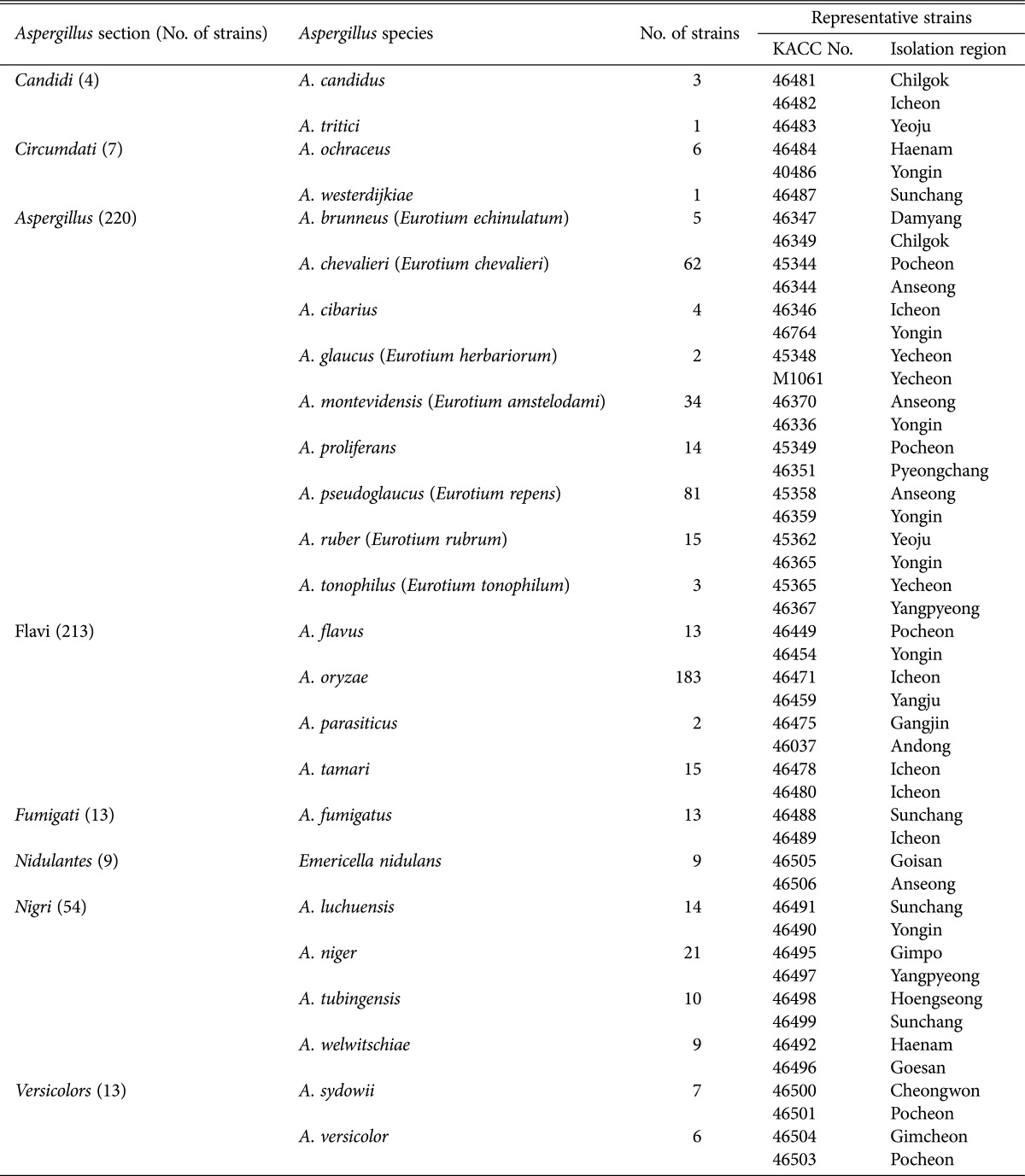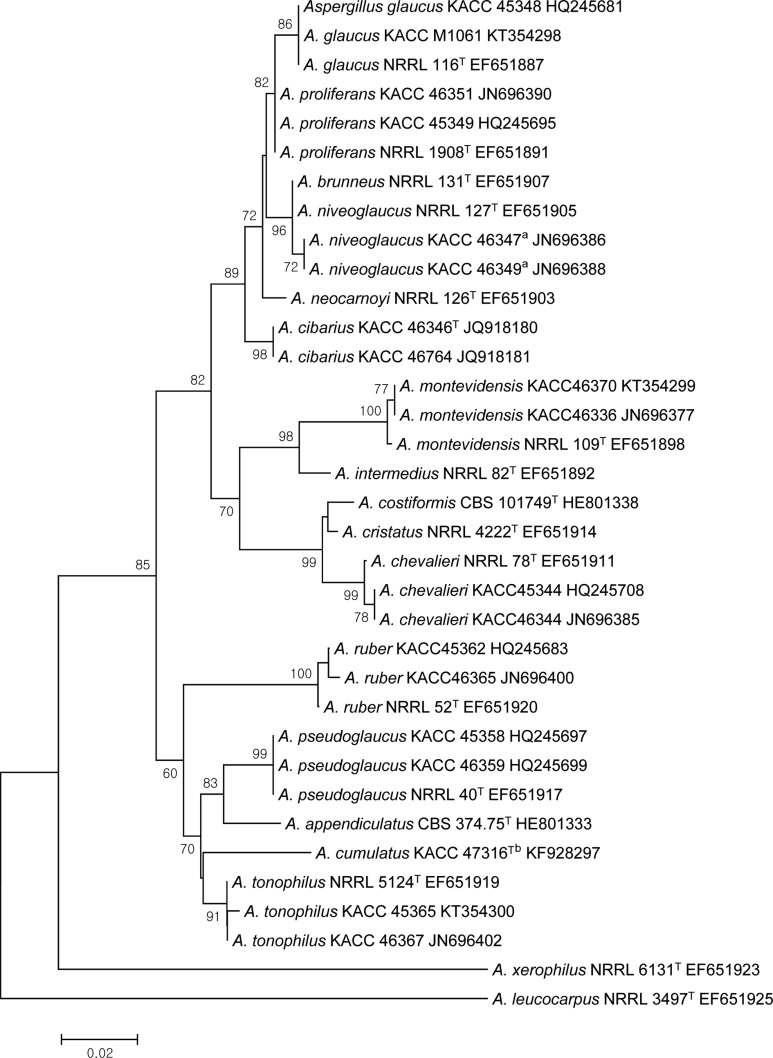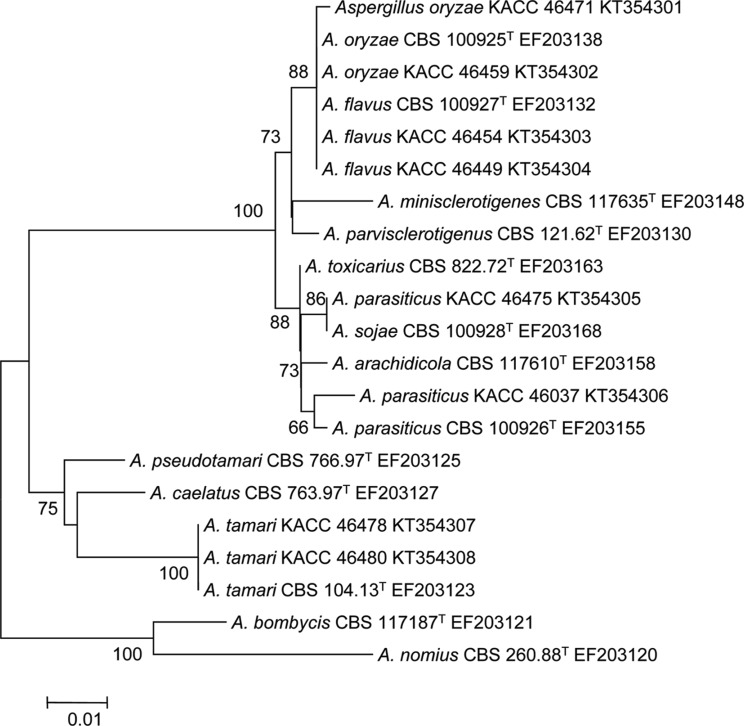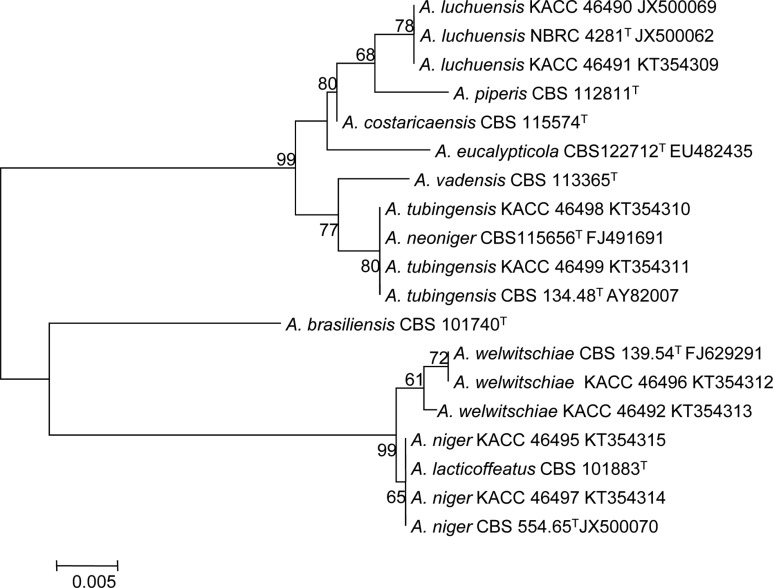Abstract
Aspergillus is an important fungal genus used for the fermentation of Asian foods; this genus is referred to as koji mold in Japan and China. A. oryzae, A. sojae, and A. tamari are used in the production of miso and shoyu in Japan, but a comprehensive taxonomic study of Aspergillus isolated from Meju, a fermented soybean starting material for traditional soy sauce and soybean paste in Korea, has not been conducted. In this study, various Aspergillus species were isolated during a study of the mycobiota of Meju, and the aspergilli were identified based on phenotypic characteristics and sequencing of the β-tubulin gene. Most strains of Aspergillus were found to belong to the following sections: Aspergillus (n = 220), Flavi (n = 213), and Nigri (n = 54). The most commonly identified species were A. oryzae (n = 183), A. pseudoglaucus (Eurotium repens) (n = 81), A. chevalieri (E. chevalieri) (n = 62), A. montevidensis (E. amstelodami) (n = 34), A. niger (n = 21), A. tamari (n = 15), A. ruber (E. rubrum) (n = 15), A. proliferans (n = 14), and A. luchuensis (n = 14); 25 species were identified from 533 Aspergillus strains. Aspergillus strains were mainly found during the high temperature fermentation period in the later steps of Meju fermentation.
Keywords: Aspergillus, Aspergillus oryzae, Aspergillus pseudoglaucus, Fermentation, Meju
Traditional Korean Meju is a fermented soybean starting material for traditional doenjang (soybean paste) and ganjang (soy sauce), which are essential sauces in authentic Korean cuisine. Meju is naturally fermented in a process involving various microorganisms, such as bacteria, yeasts, and fungi. Fungi play an important role in Meju fermentation by degrading soybean macromolecules into small nutrient molecules [1,2].
Aspergillus is an important fungal genus for the fermentation of Asian foods, and this genus are referred as "koji" molds in Japan and China [3]. Yellow koji molds, such as A. oryzae, A. sojae, and A. tamari are used in the production of shoyu and miso in Japan, and A. oryzae is also used in the production of Japanese sake [4]. Black koji molds, such as A. luchuensis, A. niger, and A. tubingensis, are used for shochu production in Japan and makgeolli production in Korea [5]. Species in section Aspergillus, such as A. ruber (Eurotium rubrum) and A. pseudoglaucus (E. repens), are used as starter cultures for Katsuobushi production [6]. Because of their importance in the fermentation industries, the taxonomy of Aspergillus strains isolated from Asian foods has been widely examined by mycologists [7,8,9].
However, a comprehensive study of Aspergillus isolated from Meju has not yet been published. A. clavatus, A. flavus, A. flavus var. columnaris, A. fumigatus, A. melleus, A. niger, A. nidulans, A. oryzae, A. oryzae var. fulvus, A. parasiticus, A. phoenicus, A. sulpureus, A. terreus, and A. versicolor were identified by Lee et al. [10], Lee [1], and Sakurai et al. [11], but the species were identified based only on morphological characteristics, and the isolates were not preserved in culture collections. Species of Aspergillus belonging to section Aspergillus, the teleomorph Eurotium, are very common in Meju, but were not reported in the studies mentioned above [1,10,11]. Recently, Aspergillus species on Meju in section Aspergillus [12] and section Nigri have been reported [13].
In this study, we report all Aspergillus species isolated from Meju in Korea. We isolated 533 strains of Aspergillus from Meju and they were identified by morphological and molecular analyses based on partial sequences of the β-tubulin gene. The previously reported species in sections Aspergillus and Nigri were reviewed and improved, and Aspergillus species in the other sections have been newly added.
MATERIALS AND METHODS
We collected 98 Meju loaves from various regions in Korea from 2008 to 2011. We isolated Aspergillus from Meju using two isolation methods, including direct plating on malt extract agar (MEA) [50 g MEA (CM0059; Oxoid, Hampshire, UK), 1 L distilled water] and dichloran 18% glycerol agar (DG18) [31.5 g dichloran-glycerol agar base (CM0729; Oxoid), 220 g glycerol, 0.1 g chloramphenicol, 1 L distilled water] and dilution plating on DG18 and dichloran rose-bengal chloramphenicol agar (DRBC) [32 g rose-bengal chloramphenicol agar base (CM0549; Oxoid), 0.002 g dichloran, 0.1 g chloramphenicol, 1 L distilled water] [12,14]. To determine which fungi grow during the Meju fermentation processes, we visited four Meju farms in Gyeonggi province each week, from molding process (late November, 2010) to submergence of the Meju in brine (mid-February, 2011). Additionally, we visited numerous Meju farms in the Chungnam, Chungbuk, Jeonnam, Jeonbuk, and Gyeongbuk provinces in mid-February 2011 to survey the Meju mycobiota present in the southern region of the Korean Peninsula. We isolated the fungi from in-process Meju by direct plating of fungi on MEA and DG18 [14].
A total of 533 strains of Aspergillus were isolated. For molecular identification, partial sequences of the β-tubulin gene (primers bt2a and bt2b) [15] were determined. The β-tubulin sequences of the strains isolated from Meju were compared with those published by Hong et al. [16], Hubka et al. [17], and Kim et al. [18] for section Aspergillus; with those published by Pildain et al. [19] for section Flavi; and with those published by Hong et al. [7] for section Nigri. The β-tubulin sequences of Aspergillus species in other sections were compared with those published by Peterson [20] and the type strains in the National Center for Biotechnology Information (NCBI) GenBank database (http://www.ncbi.nlm.nih.gov/genbank/). Forty-six representative strains were selected based on their source and molecular and morphological characteristics (Table 1). To determine the taxonomic positions of the selected strains, DNA data were analyzed using the Tamura-Nei parameter distance calculation model with gamma-distributed substitution rates, which were then used to construct a neighbor-joining tree using MEGA ver. 5.1 [21]. To determine the support for each clade, bootstrap analysis was performed with 1,000 replications (Figs. 1, 2, 3). Identification of Aspergillus species based β-tubulin sequences was confirmed by examining their morphology with reference to Raper and Fennell [22] and Klich [3].
Table 1. Number of strains and the representative strains of Aspergillus species isolated from Meju in this study.
Fig. 1. Neighbor-joining tree showing taxonomic positions of Aspergillus section Aspergillus strains isolated from Meju. Strains that have KACC No. were isolated from Meju. aKACC 46347 and 46349 could not be differentiated between A. brunneus and A. niveoglaucus, but they clustered into A. niveoglaucus both in calmodulin and RPB2 gene trees. bOnly, A. cumulatus KACC 47316T did not originate from Meju.
Fig. 2. Neighbor-joining tree showing taxonomic positions of Aspergillus section Flavi strains isolated from Meju. Strains with KACC No. were isolated from Meju.
Fig. 3. Neighbor-joining tree showing taxonomic positions of Aspergillus section Nigri strains isolated from Meju. Strains with KACC No. were isolated from Meju.
RESULTS AND DISCUSSION
Aspergillus strains were mainly found during the latter part of Meju fermentation. In particular, species of Aspergillus section Aspergillus (teleomorph Eurotium) were frequently isolated from finished Meju product. The 533 Aspergillus strains from Meju were identified as belonging to 25 species (Table 1). Most strains of Aspergillus were found to belong to sections Aspergillus (n = 220), Flavi (n = 213), and Nigri (n = 54) and the most commonly isolated species were A. oryzae (n = 183), A. pseudoglaucus (Eurotium repens) (n = 81), A. chevalieri (E. chevalieri) (n = 62), A. montevidensis (E. amstelodami) (n = 34), A. niger (n = 21), A. tamari (n = 15), A. ruber (E. rubrum) (n = 15), A. proliferans (n = 14), and A. luchuensis (n = 14).
Aspergillus section Aspergillus (teleomorph Eurotium).
Species of Aspergillus section Aspergillus, teleomorph Eurotium, comprise one of the fungal groups most frequently isolated from Meju. Members of this section germinate and grow at low moisture levels, conditions under which most other microorganisms do not grow. The moisture level of Meju is very low; in some cases, only strains belonging to section Aspergillus can grow on Meju. Of the 553 Aspergillus strains isolated from Meju, 220 were included in section Aspergillus (Table 1, Fig. 1). The predominant species was A. pseudoglaucus (Eurotium repens) (n = 81), followed by A. chevalieri (E. chevalieri) (n = 62), A. montevidensis (E. amstelodami) (n = 34), A. ruber (E. rubrum) (n = 15), A. proliferans (n = 14), A. niveoglaucus (E. niveoglaucum) (n = 5), A. cibarius (n = 4), A. tonophilus (E. tonophilum) (n = 3), and A. glaucus (E. herbariorum) (n = 2). A. cibarius was recently reported as a new species from Meju [16]. The name of the teleomorph genus, Eurotium, is typically used, but in this study we used the name Aspergillus based on Hubka et al. [17] and Samson et al. [23] to implement a single-name system in the nomenclature.
Strains belonging to section Aspergillus were primarily isolated from the surface of Meju loaves during the later stages of fermentation; however, in some instances, the strains occupied large areas inside the Meju loaves. The strains were also isolated from doenjang during the fermentation process. These species are xerophilic, show high proteolytic activity in meat, and are generally regarded as benign fungi that are free of mycotoxins [6]. Some species in the section Aspergillus have been used in food manufacturing, including as a starter culture for Katsuobushi and fish sauce [6]. Species belonging to section Aspergillus are frequently isolated from Meju, and their functions in Meju fermentation require further investigation.
Aspergillus section Flavi.
The species A. oryzae (n = 183), A. tamari (n = 15), A. flavus (n = 14), and A. parasiticus (n = 2), which belong to section Flavi, were isolated from Meju (Table 1, Fig. 2). Aflatoxin producibility was used to differentiate between A. oryzae and A. flavus, as the two species cannot be differentiated based on their β-tubulin and calmodulin gene sequences and phenotyphic characteristics. The non-aflatoxigenic Meju strain was named as A. oryzae, and the Meju strain that could produce aflatoxin was named as A. flavus [24]. A. parasiticus was also distinguished from A. sojae based on the production of aflatoxins B and G, although they could not be differentiated based on the β-tubulin tree (Fig. 2). A. tamari was easily identified by its formation of unique brown colonies on MEA. Nearly all strains in section Flavi isolated from Meju were identified as the non-aflatoxigenic species A. oryzae and A. tamari. However, the aflatoxin-producible species A. flavus and A. parasiticus were also isolated from Meju or the Meju environment, but their rate of occurrence was very low. A. parasiticus was not isolated directly from Meju, but we isolated this strain using the dilution plate method from Meju powder supplied by another researcher. We could not determine whether this strain originated from Meju or from the surrounding environment, such as the air. A. tamari is used for brewing Tamari, a form of soy sauce produced in Japan. Fifteen strains of A. tamari were isolated from Meju, and determining the industrial uses of these strains requires further study.
Although A. oryzae was frequently isolated from Meju, A. oryzae is not considered to be the predominant species in traditional Korean Meju. A. oryzae did not grow on large portions of the Meju loaves when we observed Meju at the farms [24]. This species may have been isolated at a high frequency because of culture bias; A. oryzae grows rapidly on MEA, DG18, and DRBC during dilution plating. Another possible reason is that many Meju factories have used A. oryzae as a starter culture for improved Meju production in Korea. Aflatoxin production is not thought to be a significant problem in Meju fermentation [24].
Aspergillus section Nigri.
Aspergillus species in the A. niger clade in section Nigri can be differentiated based on their molecular characteristics, such as β-tubulin and calmodulin gene sequences, although they cannot be differentiated based on their morphological characteristics. A. luchuensis, A. niger, and A. tubingensis were clearly identifiable from their β-tubulin gene sequences, but for several strains, differentiation between A. niger and A. welwitschiae was equivocal [5,7]. Of the 54 strains belonging to Aspergillus section Nigri, 21 were identified as A. niger, 14 as A. luchuensis, 10 as A. tubingensis, and 9 as A. welwitschiae (Table 1, Fig. 3) [13]. Almost black Aspergillus strains were found only on a small portion of the Meju loaf surface, but some black Aspergillus strains occupied large areas inside the Meju loaves. When growing on the surface of Meju loaves, black Aspergillus strains typically appear black because of their abundant conidiation, but they can appear white when growing inside the Meju loaves because they do not produce conidia when growing in airless environments [13]. Producers of Meju usually dislike black Aspergillus growing on Meju, because of the conidiation and color. However, A. luchuensis is one of the primary fungi employed in the production of Asian foods such as alcoholic beverages (shochu and makgeolli) and Puerh tea, and it does not produce any harmful mycotoxins [5]. This species also grows actively in Meju. Further studies are required to determine the utility of A. luchuensis on Meju.
Other Aspergillus sections.
Forty-six of the 533 Aspergillus strains isolated from Meju were determined to belong to the other sections of Aspergillus. Section Candidi was easily identified by its white conidiation [22]. Four strains belonging to section Candidi were isolated from Meju; three were identified as A. candidus and one as A. tritici (Table 1). They were differentiated based on their growth at 37℃ and their β-tubulin gene sequences. A. candidus is known to be a good lipase producer and a starter culture for processed meat manufacture [6,14].
Section Circumdati was easily differentiated by its yellow-buff conidiation [22]. Six strains of A. ochraceus and one of A. westerdijkiae were isolated from Meju and its environment (Table 1). The two species were differentiated by growth at 37oC and their β-tubulin gene sequences. A. ochraceus did not grow at 37℃, but A. westerdijkiae did grow at this temperature. Few A. ochraceus strains are toxigenic, but A. westerdijkiae is known to produce ochratoxin A [6]. One strain of A. westerdijkiae was isolated from Meju powder using the dilution plating method. We were unable to determine whether this strain was isolated from the Meju or from the environment.
Seven strains of A. sydowii and six of A. versicolor, both in section Versicolors, were isolated (Table 1). A. sydowii could be differentiated from A. versicolor by its blue-green conidiation [14]. Thirteen strains of A. fumigatus and nine strains of A. nidulans (Emericella nidulans) were also identified from Meju (Table 1).
Aspergillus species belonging to sections Aspergillus, Flavi, Nigri, and Candidi have been used as starter cultures for the production of food sauces and alcoholic beverages. They are good producers of enzymes such as cellulase, amylase, and proteases. Large numbers of these strains were isolated from Meju and were observed to grow on large areas of the exterior and interior of the Meju loaves. Therefore, to develop these strains for use in starter cultures, their roles in Meju production must be determined. However, a few Aspergillus stains belonging to the other sections were isolated from Meju, and their habitat is typically the air. Therefore, these strains may be simple contaminants of Meju.
ACKNOWLEDGEMENTS
This study was carried out with the support (project No. PJ01124801) of the National Academy of Agricultural Science, Rural Development Administration, Republic of Korea.
References
- 1.Lee SS. Meju fermentation for a raw material of Korean traditional soy products. Korean J Mycol. 1995;23:161–175. [Google Scholar]
- 2.Lee SS, Sung CK, Yu GW, Oh CH, Yu HG. Studies on safety and classification of microorganisms related to Korean traditional Meju. In: Yu JY, editor. Study on the commercial scale production of Meju for Korean fermented soybean products. Research report of Ministry of Science and Technology, Korea. Gwacheon: Ministry of Science and Technology; 1995. pp. 391–464. [Google Scholar]
- 3.Klich MA. Identification of common Aspergillus species. Utrecht: Centraalbureau voor Schimmelcultures; 2002. [Google Scholar]
- 4.Kitamoto K. Molecular biology of the koji molds. Adv Appl Microbiol. 2002;51:129–153. doi: 10.1016/s0065-2164(02)51004-2. [DOI] [PubMed] [Google Scholar]
- 5.Hong SB, Lee M, Kim DH, Varga J, Frisvad JC, Perrone G, Gomi K, Yamada O, Machida M, Houbraken J, et al. Aspergillus luchuensis, an industrially important black Aspergillus in East Asia. PLoS One. 2013;8:e63769. doi: 10.1371/journal.pone.0063769. [DOI] [PMC free article] [PubMed] [Google Scholar]
- 6.Pitt JI, Hocking AD. Fungi and food spoilage. 3rd ed. New York: Springer; 2009. pp. 275–337. [Google Scholar]
- 7.Hong SB, Yamada O, Samson RA. Taxonomic re-evaluation of black koji molds. Appl Microbiol Biotechnol. 2014;98:555–561. doi: 10.1007/s00253-013-5332-9. [DOI] [PubMed] [Google Scholar]
- 8.Murakami H. Classification of the koji mold. J Gen Appl Microbiol. 1971;17:281–309. [Google Scholar]
- 9.Murakami H. Classification system of the black Aspergilli. Taxonomic studies on Japanese industrial strains of the Aspergillus (Part 32) J Brew Soc Jpn. 1979;74:849–853. [Google Scholar]
- 10.Lee BH, Kim SJ, Lee HW. The taxonomical studies of Korean Aspergilli. Korean J Microbiol. 1968;6:6–11. [Google Scholar]
- 11.Sakurai Y, Shioda H, Komagata K, Kim CS. The physical properties and identification of molds isolated from Korean Meju. J Dongguk Univ. 1984;23:273–290. [Google Scholar]
- 12.Hong SB, Kim DH, Lee M, Baek SY, Kwon SW, Samson RA. Taxonomy of Eurotium species isolated from Meju. J Microbiol. 2011;49:669–674. doi: 10.1007/s12275-011-0376-y. [DOI] [PubMed] [Google Scholar]
- 13.Hong SB, Kim DH, Kim SH, Bang N, Kwon SW. Identification of black Aspergillus strains isolated from Meju. Korean J Mycol. 2013;41:132–135. [Google Scholar]
- 14.Samson RA, Houbraken J, Thrane U, Frisvad JC, Andersen B. Food and indoor fungi. Utrecht: CBS-KNAW Fungal Biodiversity Centre; 2010. [Google Scholar]
- 15.Glass NL, Donaldson GC. Development of primer sets designed for use with the PCR to amplify conserved genes from filamentous ascomycetes. Appl Environ Microbiol. 1995;61:1323–1330. doi: 10.1128/aem.61.4.1323-1330.1995. [DOI] [PMC free article] [PubMed] [Google Scholar]
- 16.Hong SB, Lee M, Kim DH, Meijer M, Majoor E, Vankuyk PA, Samson RA. Aspergillus cibarius sp. nov., from traditional Meju in Korea. J Microbiol. 2012;50:712–714. doi: 10.1007/s12275-012-2347-3. [DOI] [PubMed] [Google Scholar]
- 17.Hubka V, Kolarik M, Kubátová A, Peterson SW. Taxonomic revision of Eurotium and transfer of species to Aspergillus. Mycologia. 2013;105:912–937. doi: 10.3852/12-151. [DOI] [PubMed] [Google Scholar]
- 18.Kim DH, Kim SH, Kwon SW, Lee JK, Hong SB. Aspergillus cumulatus sp. nov., from rice straw and air for Meju fermentation. J Microbiol Biotechnol. 2014;24:334–336. doi: 10.4014/jmb.1312.12006. [DOI] [PubMed] [Google Scholar]
- 19.Pildain MB, Frisvad JC, Vaamonde G, Cabral D, Varga J, Samson RA. Two novel aflatoxin-producing Aspergillus species from Argentinean peanuts. Int J Syst Evol Microbiol. 2008;58(Pt 3):725–735. doi: 10.1099/ijs.0.65123-0. [DOI] [PubMed] [Google Scholar]
- 20.Peterson SW. Phylogenetic analysis of Aspergillus species using DNA sequences from four loci. Mycologia. 2008;100:205–226. doi: 10.3852/mycologia.100.2.205. [DOI] [PubMed] [Google Scholar]
- 21.Tamura K, Peterson D, Peterson N, Stecher G, Nei M, Kumar S. MEGA5: molecular evolutionary genetics analysis using maximum likelihood, evolutionary distance, and maximum parsimony methods. Mol Biol Evol. 2011;28:2731–2739. doi: 10.1093/molbev/msr121. [DOI] [PMC free article] [PubMed] [Google Scholar]
- 22.Raper KB, Fennell DI Aspergillus niger group. The genus Aspergillus. Baltimore (MD): The Williams & Wilkins Company; 1965. pp. 293–356. [Google Scholar]
- 23.Samson RA, Visagie CM, Houbraken J, Hong SB, Hubka V, Klaassen CH, Perrone G, Seifert KA, Susca A, Tanney JB, et al. Phylogeny, identification and nomenclature of the genus Aspergillus. Stud Mycol. 2014;78:141–173. doi: 10.1016/j.simyco.2014.07.004. [DOI] [PMC free article] [PubMed] [Google Scholar]
- 24.Hong SB, Lee M, Kim DH, Chung SH, Shin HD, Samson RA. The proportion of non-aflatoxigenic strains of the Aspergillus flavus/oryzae complex from Meju by analyses of the aflatoxin biosynthetic genes. J Microbiol. 2013;51:766–772. doi: 10.1007/s12275-013-3128-3. [DOI] [PubMed] [Google Scholar]






